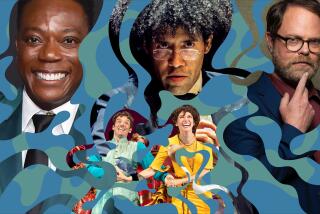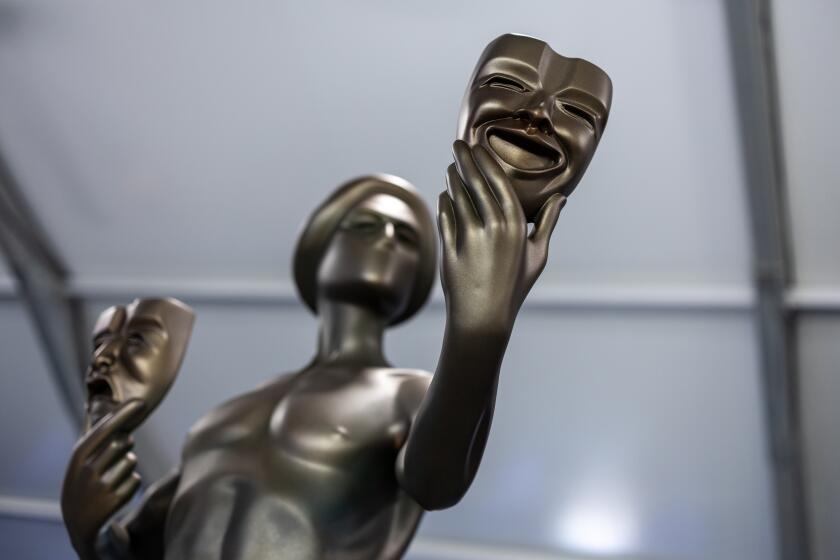Rock, Paper, Singers
- Share via
While composers Philip Glass and John Adams were conquering the opera world with, respectively, “Einstein on the Beach” (1976) and “Nixon in China” (1987), one of their peers was staying out of it.
Steve Reich wrote lots of important music during that period but never ventured an opera--until “The Cave,” created from 1989 to 1993 in collaboration with his wife, video artist Beryl Korot.
“The Cave” receives its first West Coast production Thursday through Sunday at the Irvine Barclay Theatre under the sponsorship of the Philharmonic Society of Orange County.
“I was asked to write operas in the 1970s and ‘80s, and I said no,” Reich said by phone from his home in Vermont. “I’m not interested in the sort of opera with bel canto singers on stage and an orchestra in the pit.
“I figured there was something I could do, but it wasn’t clear what that was. Then in 1988, I wrote ‘Different Trains’ [a string quartet incorporating recorded speech, written for the Kronos Quartet], which suggested if you could see people as well as hear them, if you were working with a very good video artist, as Beryl is, you could come up with another form of music theater, another form of opera. That was the genesis of ‘The Cave.’ ”
At first, they “didn’t know what the piece would be about,” Reich said. “We knew musicians would be on stage; there would be multiple viewpoints; people would speak, and the musicians would play their speech rhythms.”
*
For their subject, the two settled on the story of Abraham and his family as told in Genesis, which they had been studying “for years.”
The work’s title refers to the Cave of the Patriarchs (Machpelah), which exists in Hebron, in West Jordan, although a mosque is built above it. Abraham and some of his descendants are said to be buried in the cave. Both Muslims and Jews trace their lineage to Abraham: Jews through Isaac, his son by Sarah, his wife; Muslims through Ishmael, his son by Hagar, her servant.
*
“It’s a classic story,” Reich said. “An old man and an old woman can’t have a child. The wife suggests that he father a child on the servant. Then later, miraculously, Sarah has a child. There’s friction between the two mothers. It was just a great story of musical theater.
“Also, unfortunately, it’s at the root of the stories we read in the papers almost every day. So it was something immediately ancient and incredibly contemporary. So we set to work.”
Work meant going to the Middle East and interviewing Muslims and Jews, asking them the same questions--”Who for you is Abraham? Who is Sarah? Who is Hagar?” and so on, and recording their responses on tape. They came back to the United States and asked Americans the same questions.
“People in the Middle East know who these characters are, and people over here, with some exceptions don’t or don’t know them very well,” Reich said.
Those who did, Korot said, “reacted to these characters personally. Politics never came up. Arabs, in particular, were relieved to be talking to people with a video camera and a tape recorder and not being asked about politics, he said. The same for all the people.
“When we finally get to America, the answers get very creative and humorous. They lose some of their intensity, but they also gain a kind of creativity in terms of trying to make all these things work in the modern world.”
The two had determined that the taped interviews would be the source for all the aural and visual components of the piece.
“We probably had hundreds and hundreds of hours of tapes,” Reich said. “Beryl went through the material and cataloged it by hand. I copied the audio. If something caught my ear, I would play it several times, sample it, analyze the pitch and write it out. Then I put these things in an order that would make sense in English, tell the story, make musical sense, move from one musical phrase to the next and come out satisfactorily.”
Korot said the visual and the aural elements “are really very interdependent. It was really created as a collaboration. From the ground up, it was made together.
*
Korot had “talking heads,” she said, to begin working with. “But what else do you have? You have the frame of the image of the person. From that, I abstracted a piece of their hair, or clothing, or the ambience of the room and created almost a painted abstraction that accompanies the person. Those motifs get developed.”
Korot said she also uses double images of the people on screen. “That abstracts them so it’s not [exactly] like a television program with a talking head.”
To manage the visual material, she drew on one of the oldest cultural arts.
“When I got into video in the early ‘60s,” she said, “the weaving loom became a very important thinking tool for me in terms of how to program multiple [visual] channels. I thought of them as individual threads in a cloth. There are visual blanks because--just as in a loom--in order to have a pattern, you have to have information and no information. And the same applies with rhythm.
“It’s a very complex work,” Korot said. “It definitely deals on a formal level with a kind of cutting-edge art, both musically and visually. On a cultural level, it asks us to look at ourselves in terms of the roots of our culture. So the work starts in the Middle East but ends up in America because we’re American.
“For us it is an investigation,” she said. “Where does this take us today? It was a very moving experience to us, on that level. So there’s a lot on the plate.”
* “The Cave,” by Steve Reich and Beryl Korot, receives its West Coast premiere Thursday at the Irvine Barclay Theatre, 4242 Campus Drive. 8 p.m. Also Friday and Saturday at 8 p.m. and Sunday at 2:30 and 7:30 p.m. Presented by the Philharmonic Society of Orange County. $30-$38. (714) 740-7878.
More to Read
The biggest entertainment stories
Get our big stories about Hollywood, film, television, music, arts, culture and more right in your inbox as soon as they publish.
You may occasionally receive promotional content from the Los Angeles Times.










